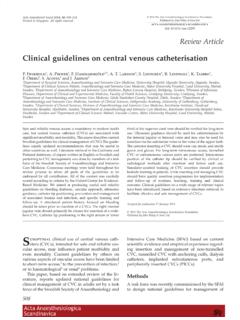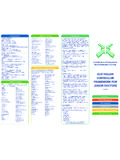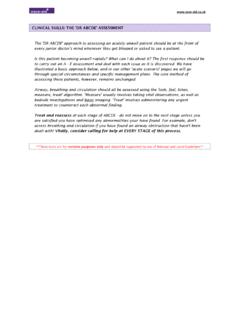Transcription of Heart failure and anaesthesia - FRCA
1 anaesthesia and Heart failure Andrew Baldock, Specialist Registrar, Southampton University Hospitals NHS Trust E mail: Self-assessment The following true/false questions may be attempted before reading the tutorial. The answers are given at the end of the text. 1. In the normal Heart : a. Pre-load is the same as left ventricular end-diastolic volume b. Increase in pre-load has no effect on the force of the next contraction c. Systemic vasoconstriction reduces afterload d. Isovolumetric ventricular contraction ends when the aortic valve opens e. The ejection fraction of a normal left ventricle is approximately 40% 2.
2 Regarding diastole: a. Diastole is an active, energy consuming process b. Diastolic time remains the same with increased Heart rate c. In the normal Heart , only one third of ventricular filling occurs before atrial contraction d. Atrial contraction is a part of diastole e. Ventricular relaxation is a part of diastole 3. Regarding Heart failure : a. The failing ventricle is invariably more compliant than normal b. Central venous pressure should be kept to a minimum if diastolic failure is suspected c. Allowing tachycardia is an effective way of maintaining cardiac output d. Vasodilation can help restore cardiac output in the failing ventricle e.
3 Inotropes should never be used 4. Regarding the management of patients with Heart failure : a. ACE inhibitors should normally be continued throughout the perioperative period b. Beta-blockers should be normally be continued throughout the perioperative period c. Arrhythmias should only be treated if blood pressure is compromised d. Spinal anaesthesia reduces perioperative risk in total knee replacement surgery Introduction Congestive cardiac failure (CCF) is a common and debilitating condition. It is characterised by impaired ventricular performance resulting in fatigue, exercise intolerance, an increased incidence of ventricular arrhythmias and a shortened life expectancy.
4 The three major risk factors for the development of Heart failure are age, hypertension and coronary artery disease. In the UK up to 4% of deaths are attributable to Heart failure and 40% of patients will die within one year of diagnosis. Perioperatively, Heart failure is associated with a substantial increase in morbidity and mortality. This review will examine the underlying pathophysiological principles of CCF and apply those principles to the clinical management of patients. Pathophysiology Characteristically the chambers of the Heart become enlarged, with increased wall thickness and stiffness. Underlying this is a process of fibrosis and myocellular hypertrophy.
5 These morphological changes lead to important functional changes which affect both diastole (relaxation) and systole (contraction). Diastole Figure 1 shows the normal left ventricular pressure-volume relationship (LVPVR) during the cardiac cycle. Diastole can be divided into three stages: 1. Isovolumetric ventricular relaxation: This is demonstrated by the vertical descending part of the pressure-volume loop. It is an active process requiring ATP, in which calcium is sequestered back into the sarcoplasmic reticulum. In diastolic Heart failure this process breaks down, resulting in a ventricle which fails to relax and is therefore stiff and less compliant.
6 2. Passive ventricular filling: In the normal Heart , approximately 75% of ventricular filling (preload) occurs passively. 3. Atrial contraction: In the normal Heart , atrial contraction contributes only a quarter of left ventricular end-diastolic volume (LVEDV) or preload. However, for a ventricle which is poorly compliant, due to diastolic failure , preload is much more dependent on atrial contraction. The dotted line in figure 1 shows how the mechanics of the LVPVR change in diastolic Heart failure . For any given left ventricular volume, there is a higher left ventricular pressure. This has two major consequences which need to be understood.
7 Firstly, there will be a decreased left atrial (LA) to left ventricular (LV) pressure gradient. LV filling in diastole depends on this pressure gradient. If LA pressure drops, LVEDV (preload) diminishes rapidly, along with stroke volume and cardiac output. Hypovolaemia is therefore poorly tolerated. (A note of caution here - the situation is quite different in acute LV systolic failure , when a reduction of preload can potentially rescue the ventricle. This is explained later). Secondly, there will be a susceptibility to develop pulmonary oedema, as the increased left sided Heart pressures result in increased pulmonary venous and capillary pressures.
8 Up to a half of patients presenting with respiratory symptoms of congestive Heart failure will have preserved systolic function. Figure 1. Left ventricular pressure-volume relationship (Dotted line indicates diastolic dysfunction) Systole Systole consists of two stages. The first stage consists of isovolumetric ventricular contraction, which ends with the opening of the aortic valve and is represented by the vertically ascending portion of the loop. The second stage concerns the ejection of blood into the aorta and ends with the closure of the aortic valve. These are ATP consuming, active processes involving the interaction of actin with myosin.
9 Systolic Heart failure occurs when there is inadequate force generation to eject blood normally. It can affect either ventricle but left-sided Heart failure is more common. Systolic failure is likely to co-exist with diastolic failure . Reduction in cardiac output, whether acute or chronic, induces a neuro-endocrine response. Baroreceptor activity increases efferent sympathetic nervous system (SNS) activity and circulating catecholamines increase. The SNS activates the renin-angiotensin-aldosterone (RAA) system. These responses initially act to maintain cardiac output and perfusion pressure but ultimately their effects become deleterious.
10 SNS activity increases myocardial oxygen consumption, which may not be met by supply. Along with a contribution from angiotensin II, the SNS also increases Ventricular Volume ESV EDV 120 80 Ventricular Pressure (mmHg) Stroke Volume Systole EDP Diastole afterload and therefore myocardial work. Sodium and water retention by the kidneys may have an adverse influence on preload and exacerbate oedema. These processes are attenuated in the medical management of congestive cardiac failure by beta-blockers, ACE inhibitors and diuretics. Figure 2 shows the relationship between LVEDV (or preload) and stroke volume (SV) described by Frank and Starling.
















